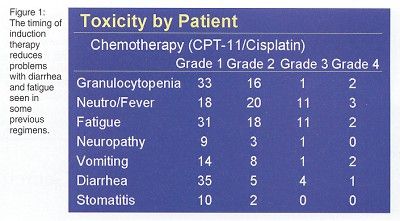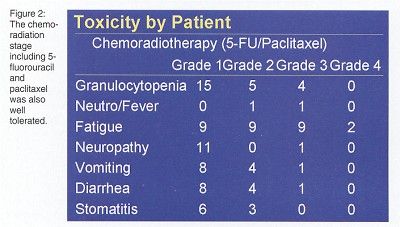Irinotecan/Cisplatin Studied as Initial and as Second-Line Treatment in Upper GI Cancers
HOUSTON-Irinotecan (Camptosar)/cisplatin (Platinol) is being studied as induction therapy for carcinoma of the esophagus and in a separate trial as second-line therapy of advanced gastric carcinoma. Jaffer A. Ajani, MD, professor of medicine at the University of Texas M. D. Anderson Cancer Center in Houston, Texas, presented information on the two trials.
HOUSTONIrinotecan (Camptosar)/cisplatin (Platinol) is being studied as induction therapy for carcinoma of the esophagus and in a separate trial as second-line therapy of advanced gastric carcinoma. Jaffer A. Ajani, MD, professor of medicine at the University of Texas M. D. Anderson Cancer Center in Houston, Texas, presented information on the two trials.
Induction Therapy
"In the first trial we adopted a strategy of treating patients who have localized carcinoma of the esophagus with induction chemotherapy followed by chemoradiation and then surgery," Dr. Ajani explained. "Patients accrued in this study are patients with adenocarcinoma or squamous cell carcinoma and local-regional disease. Every patient has an endoscopic ultrasonography for staging. Patients with T-1, N0, or T4 disease were not eligible. Patients with any M-1 disease were not eligible. T2, N0 patients were eligible because their natural history is extremely poor."
Induction chemotherapy included irinotecan at 70 mg/m² and cisplatin at 20 mg/m², each given 1 day per week for 2 weeks followed by 1 week off. "One complete cycle equals 6 weeks. Patients get four doses of this combination. Patients that have any evidence of improvement get the second cycle, so induction chemotherapy in some patients can be as long as 12 weeks," Dr. Ajani said.
When this trial was conceived, phase I data on irinotecan chemoradiation were not available, so radiation was combined with 5-fluorouracil (5-FU) at 300 mg/m² for 5 days, Monday through Friday, and 5 doses of paclitaxel at 50 mg/m², usually on Mondays. Patients are restaged 5 weeks after end of chemoradiation and then taken to surgery.
Dr. Ajani reported that this study has been completed, and data are being analyzed. "We registered 43 patients, mostly men and mostly with adenocarcinoma of the distal esophagus. Only 3 patients had mid-esophageal lesions. Most patients (84%) had T-3 lesions, and most had N positive disease. We are starting to biopsy all lymph nodes, so I expect this number to rise in future studies. Five-millimeter lymph nodes are often designated as negative, but our endoscopists are now able to biopsy celiac nodes or para-aortic nodes, so I think the staging procedure is going to get better," Dr. Ajani said.
Strategy Is Feasible
Forty-one of forty-three patients (95%) completed two induction cycles. "That means that 95% of patients had some benefit after one cycle such as relief of dysphagia or objective documentation of tumor regression and so went on to a second cycle. Ninety-eight percent of patients completed chemoradiation, which is the second step of this three-step regimen.
"Ninety-five percent of patients who completed chemoradiotherapy were able to go to surgery, which shows that this strategy is very feasible," Dr. Ajani said. Two patients have surgery pending.
Thirty-seven of 39 patients who had surgery (90%) had R-0 resections. Marked pathologic responses occurred in 25/43 (61%) patients, including 11 (27%) with pathologic complete remissions and 13 (34%) with only residual microscopic disease.
"These 13 patients had what we designate as 90% necrosis with just some islands of microscopic disease in the entire specimen. This is considered pathologic partial response by our definition. Other groups define 50% necrosis as pathologic partial response, but I think that condition exists in some of these patients, prior to treatment," Dr. Ajani said.
Dr. Ajani said that altering the timing of induction chemotherapy greatly reduced problems with diarrhea and fatigue seen in with some previous regimens (Figure 1). The chemoradiotherapy stage including 5-FU and paclitaxel was also well tolerated (Figure 2). "We almost never have to admit anyone for hospital treatment of complications with this regimen," he said.


Tolerance Is Acceptable
There were two postoperative deaths from myocardial infarction, and 10 patients developed stricture "We noticed from this and other studies that if you give preoperative chemoradiation to localized esophageal cancer patients and then take them to surgery, the number of people that eventually get stricture is much higher than with just preoperative chemotherapy.
"Irinotecan-based induction chemotherapy is feasible in esophageal cancer, and patient tolerance has been acceptable. Future esophageal studies should incorporate irinotecan in the chemoradiation phase as well as in the induction phase," Dr. Ajani said.
Second-Line Therapy
Dr. Ajani also discussed current work at M. D. Anderson using irinotecan-based combinations as second-line therapy for gastric cancer. The study enrolled 32 patients with histologic proof of unresectable, advanced adenocarcinoma of the stomach and measurable disease. Patients had received one prior nonirinotecan regimen.
The study regimen included irinotecan 50 mg/m² and cisplatin 30 mg/m², both given 1 day per week for weeks, followed by 2 weeks off. Responses were evaluated after the first, third, and fifth cycles of treatment. "I think the dose intensity in this regimen is a bit too high. We have modified the 4 weeks on, 2 weeks off schedule in our new studies because it is not very tolerable," Dr. Ajani said.
There were nine partial responses (29%) in the 29 evaluable patients. Nine patients had stable disease or minimal responses, and 11 had progressive disease. Median time to progression was 7 weeks, but the range was 5 weeks to nearly one year. Median survival was 5 months. "It is important to remember that this is median survival for a second-line regimen," Dr. Ajani said.
There was no grade 4 diarrhea, but neutropenia was frequent, including grade 4 neutropenia in 3 patients.
The main problem concerned missed or delayed doses. "Most of our patients are traveling quite far, and since this is a weekly regimen the last thing you want is have to delay or cancel the treatment due to toxicity. In a total of 65 courses, there were 15 missed doses and 31 delayed doses. Missed doses in weeks 3 and 4 were due to toxicity in 93% of cases. Delayed doses were due to toxicity in 81% of cases. Clearly we needed to modify this schedule, and we are recommending modifying the regimen to a 2 weeks on, 1 week off schedule to avoid these delays and cancellations," Dr. Ajani said.
Newsletter
Stay up to date on recent advances in the multidisciplinary approach to cancer.
Elevating the Quality of Cancer Care via Cross-Department Collaboration
Experts from Sibley Memorial Hospital discuss how multidisciplinary work has enhanced outcomes such as survival and resource use at their institution.